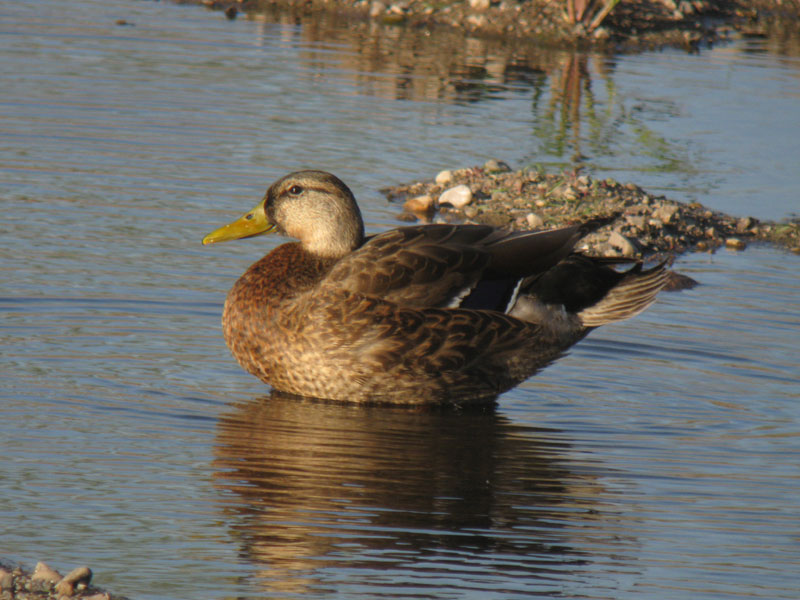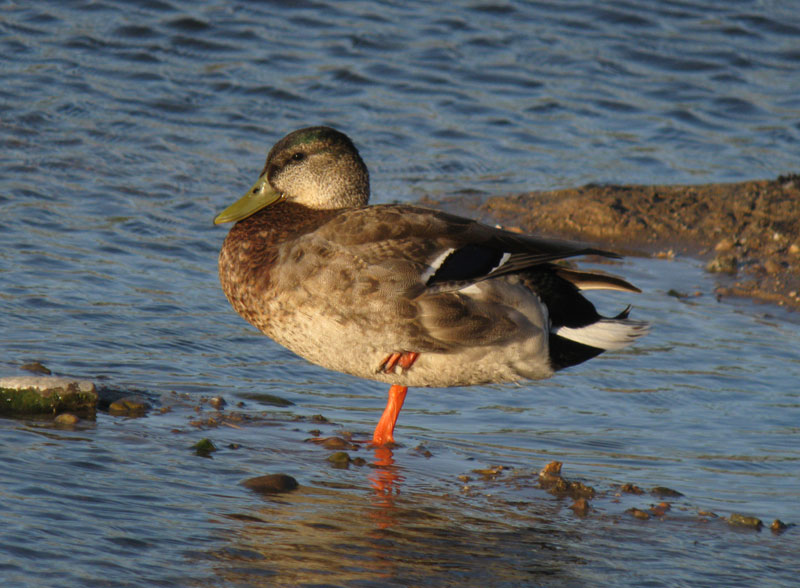The Mexican Duck was formerly considered a species (Anas diazi), and is currently lumped with Mallard (as subspecies Anas platyrhynchos diazi), but recent DNA studies suggest that Mottled Duck (not Mallard) is its closest relative (McCracken et al. 2001). Whatever its genetic background, it is clear from field observations that Mexican Ducks and Mallards interbreed freely where their ranges meet, such as around Tucson, Arizona.
In that region, a complete range of intermediate plumage states can be seen in the male ducks. Birds that look more like pure Mexican Ducks can be found more often south and east of Tucson, for example along the San Pedro River east of Sierra Vista. And, conversely, the influence of Mexican Duck spreads far to the north. On 29 April 2011, near Cottonwood, AZ, I saw several Mallards similar to the second-to-last male in these photos – with reduced neck ring, brownish throat and brown smudges on the flanks – unlike any Mallard that I see in the northeastern US. This is about 200 miles north of Tucson, and suggests that the zone of intergradation extends not only south into Mexico (as “slightly paler” Mexican Ducks, but also well to the north (as “slightly darker” Northern Mallards).
The map below shows the average plumage score of Mallards along a north-south transect in Mexico and Arizona. Mexican data is from Scott and Reynolds (1984), Arizona data is estimated from personal field observations. Scott and Reynolds described the variation as a “smooth cline” of increasing darkness to the south, but their sample size was limited (averaging under 9 birds from each of six locations) and one location in the middle of their samples showed a stronger Northern influence than the others. Their data could just as easily be interpreted as a relatively uniform Mexican-like population south of the border, especially since all of their birds scored closer to Mexican, and not a single one closer to Northern. Field observations north of the border suggest a very steep cline from mostly Mexican-like southeast of Tucson, to highly variable but mostly Northern-like at Tucson, to almost pure Northern-like in central Arizona (but again, these sample sizes are small and surveys informal).

The series of photos below were all taken at Sweetwater Wetlands, Tucson, AZ on 3 May 2011; copyright David Sibley.








References
McCracken, K. G. , W. P. Johnson, & F. H. Sheldon. 2001. Molecular population genetics, phylogeography, and conservation biology of the mottled duck (Anas fulvigula). Conservation Genetics 2: 87-102.
Scott, N. J., Jr., and R. P. Reynolds. 1984. Phenotypic Variation of the Mexican Duck (Anas platyrhynchos diazi) in Mexico. Condor 86: 266-274. http://elibrary.unm.edu/sora/Condor/files/issues/v086n03/p0266-p0274.pdf
Webster. R. 2006. The Status of Mottled Duck (Anas fulvigula) in Arizona. Arizona Birds Online 2: 6-9. http://www.azfo.org/journal/volumes/Volume2-3.pdf


September 1st hubby and I ate at L’Auberge Restaurant on Oak Creek. Ate creek side which had around 20 of these unusual ‘mallards’. Drakes look VERY much like hens, only a little blue feathering is more indicative of males. Males also have brown heads with dark brown streaks. A couple drakes and a hen with a still-fuzzy duckling took to ‘beseeching’ diners for tidbits.
Oops, Oak Creek, Sedona, AZ
Pingback: Mottled Duck and Mexican Duck - Almost Mallards - Taylor County Big Year 2019
Pingback: Confirmed Mexican Duck Seen in Yavapai County – Birding the Verde Valley
Pingback: The Bird We Always-Never Knew - American Birding Association